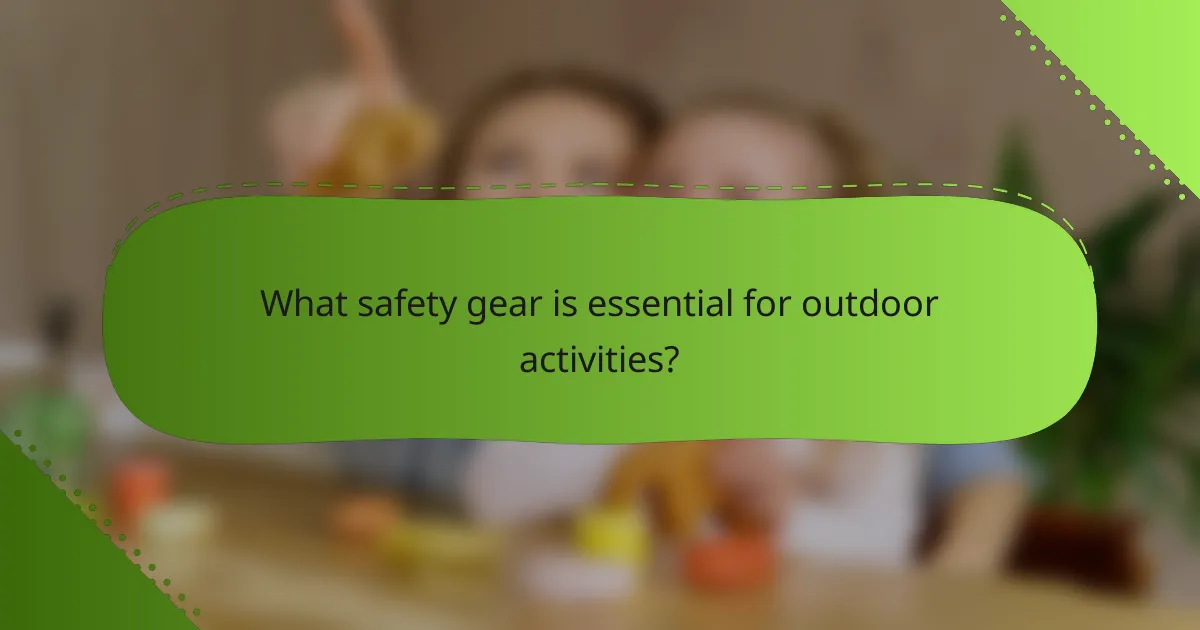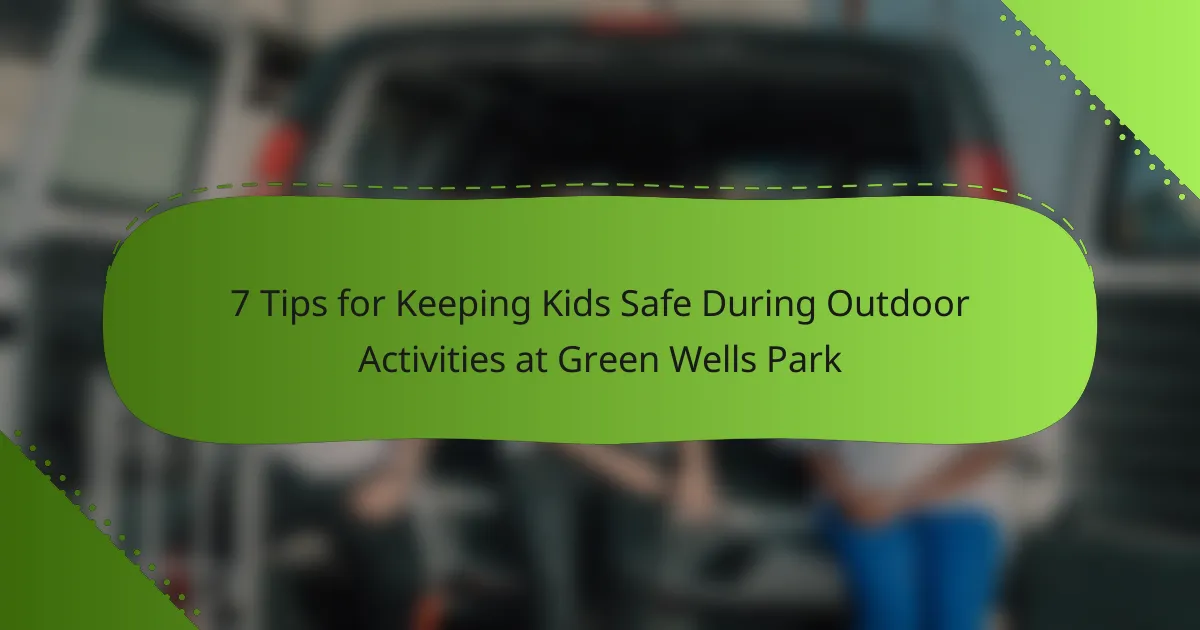Ensuring the safety of children during outdoor activities at Green Wells Park is essential for a fun and worry-free experience. By actively supervising kids, setting clear boundaries, and utilizing appropriate safety gear, parents can significantly reduce risks. Implementing best practices such as inspecting equipment and being mindful of weather conditions further enhances safety, allowing children to fully enjoy their time outdoors.

How can parents ensure safety at Green Wells Park?
Parents can ensure safety at Green Wells Park by actively supervising their children, establishing clear boundaries, and using appropriate safety gear. These measures help create a secure environment for kids to enjoy outdoor activities while minimizing risks.
Supervise children closely
Close supervision is essential to keep children safe during outdoor activities. Parents should maintain a visual and auditory connection with their kids, especially in busy areas like playgrounds or near water features. Regularly checking in and engaging with them can help prevent accidents.
Consider using a designated meeting spot in case a child wanders off. This ensures they know where to go if they become separated, enhancing their safety while allowing for some independence.
Establish clear boundaries
Setting clear boundaries helps children understand where they can play and explore. Define specific areas for activities, such as play zones or picnic spots, and communicate these limits effectively. Use markers or signs to reinforce these boundaries visually.
Discuss the importance of staying within these areas to prevent accidents or getting lost. Regular reminders can help children remember the rules while they play.
Use safety gear
Using appropriate safety gear is crucial for protecting children during outdoor activities. Helmets, knee pads, and elbow pads are essential for activities like biking or skating. Ensure that the gear fits properly and is in good condition.
For water activities, life jackets should be worn by children who are not strong swimmers. Always check that the safety gear meets local safety standards to provide adequate protection.
Teach emergency procedures
Teaching children emergency procedures prepares them for unexpected situations. Discuss what to do if they get lost, encounter a stranger, or need help. Role-playing these scenarios can reinforce their understanding and boost their confidence.
Make sure children know how to contact an adult or emergency services if needed. Providing them with a simple way to remember important phone numbers can be beneficial.
Encourage buddy systems
Implementing a buddy system can enhance safety during outdoor activities. Pair children with a friend or sibling to look out for each other. This not only promotes safety but also encourages teamwork and social interaction.
Remind kids to stay together and communicate if they plan to explore different areas. This approach can significantly reduce the chances of accidents or getting lost.

What safety gear is essential for outdoor activities?
Essential safety gear for outdoor activities includes items that protect against injuries and ensure safety in various environments. Depending on the activity, specific gear like helmets, life jackets, and first aid kits can significantly reduce risks and enhance safety for children.
Helmets for biking and skating
Helmets are crucial for protecting children’s heads during biking and skating. They should fit snugly and meet safety standards such as those set by the Consumer Product Safety Commission (CPSC) in the U.S. or similar regulations in your country.
When choosing a helmet, look for features like adjustable straps and ventilation. Encourage kids to wear their helmets every time they ride or skate, as this simple step can prevent serious injuries.
Life jackets for water activities
Life jackets are vital for children participating in water activities such as swimming, kayaking, or paddleboarding. Ensure that the life jackets are U.S. Coast Guard-approved or meet local safety standards, providing adequate buoyancy for the child’s weight.
Fit is essential; the life jacket should be snug but not restrictive. Teach children the importance of wearing life jackets at all times when near or in water, as this can save lives in emergencies.
First aid kits for minor injuries
A well-stocked first aid kit is essential for addressing minor injuries that may occur during outdoor activities. Kits should include items like adhesive bandages, antiseptic wipes, gauze, and pain relievers suitable for children.
Regularly check and replenish the kit to ensure it contains all necessary supplies. Educate children on basic first aid practices, such as cleaning a scrape and applying a bandage, to empower them to handle minor injuries confidently.

What are the best practices for outdoor play?
Best practices for outdoor play focus on ensuring children’s safety while they engage in physical activities. This includes selecting appropriate locations, inspecting equipment, and being aware of weather conditions to create a secure environment for kids.
Choose safe play areas
Selecting safe play areas is crucial for preventing accidents. Look for locations that are well-maintained, free from sharp objects, and away from traffic. Parks like Green Wells Park often have designated play zones that are specifically designed for children’s activities.
Consider the surface of the play area as well. Soft surfaces such as grass, rubber mats, or wood chips can help cushion falls, reducing the risk of injury. Always check for any potential hazards in the vicinity, such as water bodies or steep slopes.
Check equipment for hazards
Before allowing children to use playground equipment, inspect it for any hazards. Look for broken parts, sharp edges, or loose fittings that could pose a risk. Equipment should meet safety standards, and any damaged items should be reported to park authorities.
Encourage children to use equipment appropriately, such as sliding feet-first and not overcrowding swings. Regular maintenance checks by park staff can help ensure that the equipment remains safe for use.
Monitor weather conditions
Weather conditions can significantly impact outdoor play safety. Always check the forecast before heading out, as extreme heat, rain, or storms can create unsafe conditions. For instance, avoid play during high heat to prevent heat exhaustion.
In colder months, be cautious of icy surfaces that can lead to slips and falls. Dress children appropriately for the weather, ensuring they have suitable clothing and footwear to stay comfortable and safe during their outdoor activities.

How to prepare for outdoor emergencies?
Preparing for outdoor emergencies involves having a clear plan and the necessary knowledge to respond effectively. This includes understanding how to communicate, knowing nearby medical facilities, and teaching children how to seek help when needed.
Have a communication plan
A communication plan is essential for ensuring everyone knows how to stay in touch during outdoor activities. Establish a designated meeting point in case anyone gets separated, and ensure all family members or group participants have a way to communicate, such as mobile phones or walkie-talkies.
Consider using a group messaging app to keep everyone updated on plans and changes. Make sure to test devices before heading out to ensure they are functional and fully charged.
Know the location of the nearest hospital
Identifying the nearest hospital before your outdoor adventure is crucial. Familiarize yourself with the route and estimated travel time to the facility, as this can vary significantly depending on the park’s location and traffic conditions.
Keep a list of emergency contacts, including the hospital’s phone number, in your first aid kit or on your mobile device. This ensures quick access to help if an injury occurs.
Teach kids how to call for help
Teaching children how to call for help is a vital safety skill. Ensure they know how to use a phone, including dialing emergency services and providing their location and details about the situation.
Role-play different scenarios with your kids, such as what to say when calling for help or how to approach a park ranger or another adult if they feel unsafe. Reinforce the importance of staying calm and clearly communicating their needs.

What are the local wildlife safety tips?
When visiting Green Wells Park, it’s essential to prioritize safety around local wildlife. Understanding how to interact with animals can prevent dangerous situations and protect both visitors and the animals.
Avoid feeding wild animals
Feeding wild animals can lead to aggressive behavior and dependency on human food. Animals that become accustomed to being fed may approach people more frequently, increasing the risk of bites or other injuries.
In Green Wells Park, it’s best to observe wildlife from a distance. If you want to enjoy the beauty of nature, consider bringing snacks for yourself rather than sharing with animals. This practice helps maintain their natural foraging instincts and keeps them safe.
Additionally, be aware that feeding animals is often against park regulations. Violating these rules can lead to fines or other penalties, so it’s wise to respect the guidelines in place for everyone’s safety.
